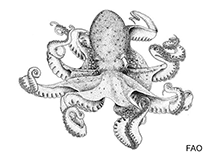Pinnoctopus cordiformis (Quoy & Gaimard, 1832)
تصوير گوگل | No image available for this species;
drawing shows typical species in Octopodidae.
رده بندی / Names اسامي عام | مترادف | CoL | ITIS | WoRMS
Cephalopoda | Octopoda | Octopodidae | Octopodinae
Environment: milieu / climate zone / تغييرات عمق / distribution range بوم شناسي
وابسته به آب سنگ; تغييرات عمق 0 - 300 m (مرجع 122140). Subtropical; 14°C - 22°C (مرجع 122726); 28°S - 48°S, 129°E - 171°W
Distribution كشورها | مناطق سازمان خوار و بار جهاني (FAO) | Ecosystems | ظهور | معرفي
Indo-West Pacific: Australia, New Zealand and Chatham Island.
Length at first maturity / Size / Weight / سن
بلوغ: Lm ? range ? - ? cm Max length : 200 cm TL جنس نر / بدون خواص جنسي; (مرجع 122140); بيشينه وزن گزارش شده: 2.3 kg (مرجع 122140)
Life cycle and mating behavior بلوغ | تولید مثل | تخم ریزی | Eggs | Fecundity | Larvae
مآخذ اصلی
مراجع | هماهنگ كننده | همكاران
Carrasco, S.A. 2014 The early life history of two sympatric New Zealand octopuses: eggs and paralarvae of Of Octopus huttoni and Pinnoctopus cordiformis. New Zealand Journal of Zoology 41(1):32-45. (مرجع 122140)
وضعيت در فهرست قرمز IUCN
(مرجع 130435: Version 2025-1)
وضعيت از نظر سايتس (مرجع 108899)
CMS (مرجع 116361)
خطر برای انسان ها
استفاده انسانی
ماهي گيري – شيلات: تجاري
| FishSource |
ابزارها
اطلاعات بيشتر
Max. ages / sizes
Length-weight rel.
Length-length rel.
نوسانات طولی
Mass conversion
فراواني
منابع اينترنتي
BHL | BOLD Systems | CISTI | DiscoverLife | FAO(Publication : search) | Fishipedia | GenBank (ژنوم, نوکلئوتيد) | GloBI | Gomexsi | Google Books | Google Scholar | Google | PubMed | Tree of Life | Wikipedia (برو, جستجو) | Zoological Record



